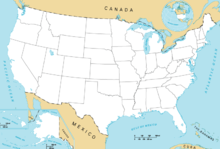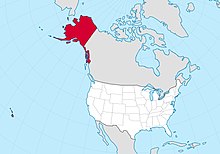Contiguous United States


Thecontiguous United States(officially theconterminous United States) consists of the 48 adjoiningU.S. statesand theDistrict of Columbiaof theUnited States of Americain centralNorth America.[1][2]The term excludes the only two non-contiguousstates, which areAlaskaandHawaii(they are also the last two states to beadmitted to the Union), and all other offshoreinsular areas,such as theU.S. territoriesofAmerican Samoa,Guam,theNorthern Mariana Islands,Puerto Rico,and theU.S. Virgin Islands.[3][4]The colloquial term "Lower48"[5]is also used, especially in relation to Alaska.
The related but distinct termcontinental United Statesincludes Alaska, which is also on North America, but separated from the 48 states byBritish Columbiain Canada, but excludes Hawaii and all the insular areas in theCaribbeanand thePacific.[1][6]
The greatest distance (on agreat-circleroute) entirely within the contiguous U.S. is 2,802 miles (4,509 km), coast-to-coast betweenFloridaand theState of Washington;[7]the greatest north–south line is 1,650 miles (2,660 km).[8]The contiguous United States occupies an area of 3,119,884.69 square miles (8,080,464.3 km2). Of this area, 2,959,064.44 square miles (7,663,941.7 km2) is actual land, composing 83.65 percent of the country's total land area, and is comparable in size to the area of Australia.[9]Officially, 160,820.25 square miles (416,522.5 km2) of the contiguous United States is water area, composing 62.66 percent of the nation's total water area.
The contiguous United States, if it were a country, would be fifth on thelist of countries and dependencies by area,behindRussia,Canada,China,andBrazil.However, the total area of the United States, including Alaska and Hawaii, ranks third or fourth. Brazil is 431,000 square kilometers (166,000 sq mi) larger than the contiguous United States, but smaller than the entire United States including Alaska, Hawaii and overseas territories. The2020 U.S. censuspopulation of the area was 328,571,074, comprising 99.13 percent of the nation's total population, and a density of 111.04 inhabitants/sq mi (42.872/km2), compared to 93.844/sq mi (36.233/km2) for the nation as a whole.[10]
Other terms
[edit]Whileconterminous U.S.has the precise meaning ofcontiguous U.S.(both adjectives meaning "sharing a common boundary" ), other terms commonly used to describe the 48 contiguous states have a greater degree of ambiguity.
Continental and mainland United States
[edit]BecauseAlaskais also a part ofNorth America,the termcontinental United Statesalso includes that state, so the term is qualified with the explicit inclusion of Alaska to resolve any ambiguity.[3][11][12][13]On May 14, 1959, theUnited States Board on Geographic Namesissued the following definitions based partially on the reference in the Alaska Omnibus Bill, which defined the continental United States as "the 49 States on the North American Continent and the District of Columbia..." The Board reaffirmed these definitions on May 13, 1999.[1]However, even before Alaska became a state, it was properly included within the continental U.S. due to being anincorporated territory.[14]
The termmainland United Statesis sometimes used synonymously withcontinental United States,but technically refers only to those parts of states connected to the landmass of North America, thereby excluding not onlyHawaiiand overseasinsular areas,but also islands which are part of continental states but separated from the mainland, such as theAleutian Islands(Alaska),San Juan Islands(Washington), theChannel Islands(California),the Keys(Florida), thebarrier islands(GulfandEast Coaststates), andLong Island(New York).[15]
CONUS and OCONUS
[edit]CONUS,a technical term used by theU.S. Department of Defense,General Services Administration,NOAA/National Weather Service,and others, has been defined both as the continental United States, and as the 48 contiguous states.[16][17]The District of Columbia is not always specifically mentioned as being part ofCONUS.[17]
OCONUSis derived from CONUS withOfor outside added, thus referring to Outside of Continental United States.[16][18]
The lower 48
[edit]The termlower 48is also used to refer to the conterminous United States. TheNational Geographicstyle guide recommends the use ofcontiguousorconterminous United Statesinstead oflower 48when the 48 states are meant, unless used in the context of Alaska.[5][19]Almost all of Hawaii is south of the southernmost point of the conterminous United States in Florida.
Zone of the Interior
[edit]DuringWorld War II,the first fournumbered Air Forcesof theUnited States Army Air Forces(USAAF) were said to be assigned to theZone of the Interiorby the American military organizations of the time—the future states ofAlaskaandHawaii,then each onlyorganized incorporated territoriesof the Union, were respectively covered by theEleventh Air ForceandSeventh Air Forceduring the war.[citation needed]
Terms used in the non-contiguous U.S. jurisdictions
[edit]Residents of Alaska, Hawaii and off-shoreU.S. territorieshave unique labels for the contiguous United States because of their own locations relative to them.
Alaska
[edit]The vast territory ofAlaskabecame the 49th state of the United States on January 3, 1959. Alaska is the northwest extremity of the North American continent, separated from theU.S. West Coastby theCanadian provinceofBritish Columbia.The termLower 48has, for many years, been a common Alaskan equivalent for "contiguous United States";[20][21]today, many Alaskans use the term"Outside"for those states, though some may use "Outside" to refer toanylocation not within Alaska.[22]
Hawaii
[edit]The territory ofHawaii,consisting of the entireHawaiian Islandsarchipelago except forMidway Atoll,[a]became the 50th state of the United States on August 21, 1959. It is the southernmost U.S. state, and the latest one to join the Union. Not part of any continent, Hawaii is located in thePacific Ocean,about 2,200 miles (3,541 km) from North America and almost halfway between North America andAsia.In Hawaii andoverseas American territories,for instance, the termsthe MainlandorU.S. Mainlandare often used to refer to the 49 states in North America.[23][24]
Puerto Rico
[edit]Puerto Rico is anunincorporated territoryof the United States located in the northeastCaribbean Sea,approximately 1,000 miles (1,609 km) southeast ofMiami,Florida.Puerto Ricans born in Puerto Rico are U.S. citizens and are free to move to the mainland United States. The termStateside Puerto Ricanrefers to residents of any U.S. state or the District of Columbia who were born in, or can trace their family ancestry to, Puerto Rico.[25]
U.S. Virgin Islands
[edit]TheU.S. Virgin Islandsis aU.S. territorylocated directly to the east of Puerto Rico in the Caribbean Sea.[26]The term "stateside" is used to refer to the mainland, in relation to the U.S. Virgin Islands[27](seeStateside Virgin Islands Americans).
American Samoa
[edit]American Samoais aU.S. territorylocated in theSouth Pacific OceaninPolynesia,south of the equator — it is 2,200 miles (3,500 km) southwest ofHawaii.[28]In American Samoa, the contiguous United States is called the "mainland United States" or "the states"; those not from American Samoa are calledpalagi(outsiders).[29]
Non-contiguous areas within the contiguous United States
[edit]Apart from off-shoreU.S. islands,a few continental portions of the contiguous United States are accessible by road only by traveling through Canada.Point Roberts, Washington;Elm Point, Minnesota;and theNorthwest AngleinMinnesotaare three such places.Alburgh, Vermont,is not directly connected by land, but is accessible by road via bridges from within Vermont and from New York.[30]By contrast,Hyder, Alaska,is physically part of contiguous Alaska and its easternmost town, but the only practical access is by road through Canada or by seaplane.
List of contiguous U.S. states
[edit]The 48 contiguous states are:
- Alabama
- Arizona
- Arkansas
- California
- Colorado
- Connecticut
- Delaware
- Florida
- Georgia
- Idaho
- Illinois
- Indiana
- Iowa
- Kansas
- Kentucky
- Louisiana
- Maine
- Maryland
- Massachusetts
- Michigan
- Minnesota
- Mississippi
- Missouri
- Montana
- Nebraska
- Nevada
- New Hampshire
- New Jersey
- New Mexico
- New York
- North Carolina
- North Dakota
- Ohio
- Oklahoma
- Oregon
- Pennsylvania
- Rhode Island
- South Carolina
- South Dakota
- Tennessee
- Texas
- Utah
- Vermont
- Virginia
- Washington
- West Virginia
- Wisconsin
- Wyoming
In addition, theDistrict of Columbiais within the contiguous United States.
See also
[edit]- Extreme points of the United States
- Mainland
- Metropolitan France,nicknamed "l'Hexagone", an analogous concept in France
Notes
[edit]- ^Midway is an unorganized and unincorporated territory of the United States.
References
[edit]- ^abc"What constitutes the United States, what are the official definitions?".U.S. Geological Survey.Archivedfrom the original on November 16, 2017.RetrievedJanuary 30,2019.
- ^"United Airlines website".Archived fromthe originalon April 2, 2012.RetrievedApril 4,2012.
Contiguous United States:The 48 adjoining states and the District of Columbia.
- ^abRandom House (1991).Random House Webster's College Dictionary.New York: Random House.ISBN0-679-40110-5.
- ^These maps show the contiguous 48 states and D.C., but not Alaska and Hawaii.
- "Military Bases in the Contiguous United States".National Park Service, U.S. Department of the Interior.Archivedfrom the original on December 26, 2018.RetrievedNovember 28,2012.
- "Soil Moisture Regimes of the Contiguous United States".U.S. Department of Agriculture. Archived fromthe originalon May 13, 2013.RetrievedNovember 28,2012.
- ^ab"National Geographic Style Manual: Alaska".Archived fromthe originalon October 28, 2011.RetrievedDecember 6,2013.
The continental United States includes Alaska. [...] In Alaska context,lower forty-eightorlower 48may be used. Do not hyphenatelower 48as an adjective. The termoutsidemay be put in quotes on first reference if ambiguous. To distinguish the 48 states from the 49 or 50, usecontiguousorconterminous.
- ^Hyslop, Stephen G. (April 5, 1996).Political Geography of the United States.Guilford Press.p. 90.
- ^Pickover, Cliff."The Longest Line in America!".University of Wisconsin.Archivedfrom the original on June 9, 2014.RetrievedOctober 15,2013.
- ^"HowStuffWorks" Geography of the United States - Geography "".Geography.howstuffworks. March 30, 2008. Archived fromthe originalon January 19, 2016.RetrievedOctober 29,2013.
- ^"Field Listing: Area".The World Factbook.cia.gov. Archived fromthe originalon July 7, 2020.RetrievedJune 13,2019.
- ^"Resident Population Data - 2010 Census".United States Census Bureau. Archived fromthe originalon October 28, 2011.RetrievedJanuary 30,2011.
- ^"National Geographic Style Manual".Archivedfrom the original on January 2, 2016.RetrievedApril 4,2012.
Thecontinental United Statescomprises the 48 contiguous, or conterminous, states plus Alaska.
- ^"United Cargo website".Archived fromthe originalon April 2, 2012.RetrievedApril 4,2012.
Continental United States:The 48 adjoining states, Alaska and District of Columbia.
- ^"Alaska Airlines website".Archivedfrom the original on February 21, 2011.RetrievedApril 4,2012.
The Continental U.S. includes the lower 48 states as well as the State of Alaska, unless otherwise specified.
- ^"In the absence of any such statement, Alaska would be regarded as a part of the continental United States."Inland Marine and Transportation Insurance (1949)
- ^Hyslop, Stephen G. (April 5, 1996).Political Geography of the United States.Guilford Press.pp. 105–110.
- ^ab"Per Diem Rates (CONUS and OCONUS)".United States General Services Administration.Archivedfrom the original on September 21, 2010.RetrievedSeptember 21,2010.
- ^ab"U.S. Navy Style Guide".Archived fromthe originalon March 11, 2015.RetrievedNovember 24,2008.
CONUS - "Continental United States." CONUS refers to the 48 contiguous states. It is not synonymous with United States. CONUS is acceptable on first reference.
"CONUS" seems to be used primarily by the American military and the Federal government and those doing business with them. - ^"Glossary of Army Terms".Archivedfrom the original on June 25, 2012.RetrievedApril 4,2012.
"OCONUS: Outside Continental United States
- ^"National Geographic Style Manual: conterminous, or contiguous, continental, continental United States".Archivedfrom the original on January 2, 2016.RetrievedSeptember 22,2011.
Use contiguous, or conterminous, for the 48 states. The continental United States comprises the 48 contiguous, or conterminous, states plus Alaska.
- ^"Learn to Speak Alaskan - Alaskan Language Tips - Princess Lodges".princesslodges.Archivedfrom the original on September 14, 2009.RetrievedMarch 2,2009.
- ^"ALASKA: State Profile".Archived fromthe originalon January 26, 2010.RetrievedDecember 6,2013.
- ^Journal, Copper River Country."Speaking Alaskan: Words Alaskans Say".Archivedfrom the original on August 20, 2018.RetrievedAugust 20,2018.
- ^Edles, Laura Desfor (2003)."'Race,' 'Ethnicity,' and 'Culture' in Hawai'i: The Myth of the 'Model Minority' State ".In Loretta I. Winters and Herman L. DeBose (ed.)New Faces in a Changing America: Multiracial Identity in the 21st Century.SAGE Publications. p. 241.ISBN9780761923008.
- ^Hyslop, Stephen G. (April 5, 1996).Political Geography of the United States.Guilford Press.p. 65.
- ^Five million Puerto Ricans now living in the mainland U.S.Archived2013-12-18 at theWayback MachineCaribbean Business. 27 June 2013. Vol 41. Issue 24. Retrieved 13 December 2013.
- ^"United States Virgin Islands".Encyclopaedia Britannica.Archivedfrom the original on July 31, 2022.RetrievedJuly 2,2020.
- ^"U.S. Virgin Islands - Health and Safety".Frommers.Archivedfrom the original on July 3, 2020.RetrievedJuly 2,2020.
- ^"American Samoa".Encyclopaedia Britannica.Archivedfrom the original on August 31, 2022.RetrievedJuly 2,2020.
- ^Mack, Doug.The Not-Quite States Of America.pp. 67, 88, 91.
- ^Ross, Oakland (June 3, 2011)."Orphans of the atlas".Toronto Star.Archivedfrom the original on June 8, 2011.RetrievedJune 5,2011.
External links
[edit]- Definition ofcontinental
- Definition ofcontiguous
- Definition ofcoterminousandconterminous
